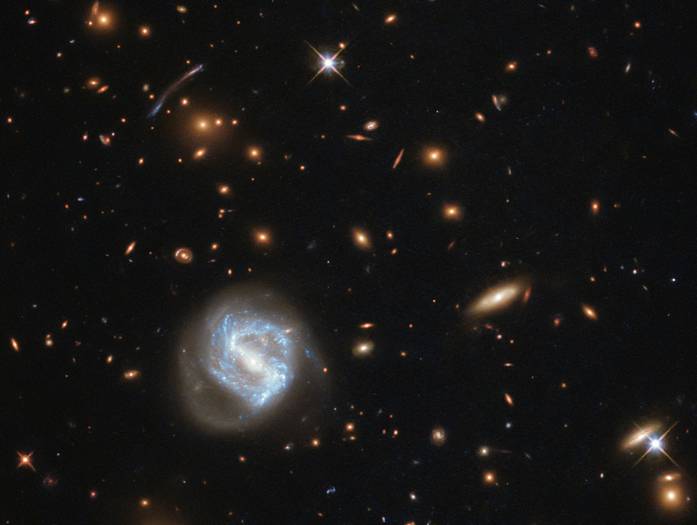The image is of the galaxy cluster known as SDSS J0333+0651. Image © ESA/Hubble & NASA
This galaxy cluster is particularly interesting for astronomers to study the star-forming regions which are not typically very large. The star-forming region stretches out for a few hundred light-years at most and so our current telescope technology can not detect them. But astronomers searched for another cosmic trick; they search instead for galaxy clusters, which have a gravitational influence so immense that they warp the space-time around them. This distortion acts as a lens, magnifying the light of galaxies (and their star-forming regions) sitting far behind the cluster and producing elongated arcs like the one seen in the upper left part of the above image.
Previously we have discussed the determination of galaxy mass by the application of velocity dispersion method and here we will discuss on using the Virial theorem for determining the average mass of components (including galaxies) galaxy cluster
The application of Virial Theorem to a cluster of galaxies yields the total mass of the cluster and so the average mass of an individual galaxy in that cluster.
Also Read: What Process Creates and Maintains the Spiral Arms Around Spiral Galaxies?
A galaxy cluster is a group of gravitationally bound galaxies that number from the hundreds to the tens of thousands.
To apply the Virial theorem, the galaxy cluster demands that the cluster consists of a stable group of a point mass. This theorem also neglects the existence of invisible mass in the form of atomic or molecular gas or dust and demands no subgrouping like binary or multiple subsystems within the cluster. This implies that for the Virial theorem one must be content to accept that the individual point masses that are being observed only contribute to the entire mass of the cluster and these point masses are moving only under the smooth gravitational field of the cluster as a whole.
Now the average mass of these individual members or statistical distribution of mass among these can be obtained using the Virial theorem.
Mathematically, if <m> be the average mass of N galaxies observed in the cluster of mean radius R, then the Virial theorem for the cluster is
<m> N <𝒗2> = G <m2> N2 / R
Where <𝒗2> is the mean-square velocity for the cluster members obtained by multiplication of the observed radial velocities of the members by some suitable factor.
So, now the motion of the centre of mass of the galaxy cluster and the random motions of the member galaxies with respect to the centre of mass are coupled together but remember as we are following the path of generalization this may produce some uncertainty in the finally calculated results. The potential energy of the cluster actually depends on the separation of the individual members from each other. But for distant clusters, this is hardly possible to determine and the average radius of the cluster can be conveniently used.
When all this was done and calculated the value, astronomers found the value to be unusually high and also the mass value increased progressively with the distances of the clusters. This anomalous nature baffled astronomers and astronomers were led to the assumption that one or more computations may be invalid or need to be considered.
To resolve the over calculation shown by the Virial theorem astronomers assumed different possibilities like the stability of the cluster, assumption of the constant mass, etc. Then finally by different observational results, astronomers reached the point of the existence of missing mass in the universe - dark matter.
All current theoretical, as well as observational considerations, definitely indicate that the existence of invisible matter (dark matter) is real in the galaxies and clusters of galaxies.
